Thank you for helping us meet our fundraising goal!
I read lots of articles these days pointing to the rapid expansion of renewable energy as a reason to be hopeful about our unfolding climate crisis. Unfortunately, the climate doesn't care how many solar panels and wind farms we build.
What determines our climate fate is how much climate-polluting fossil fuels we decide to burn. Renewables are great but only if they actually replace oil, gas, or coal. Sadly, rising renewables haven't stopped our fossil fuel burn, or our atmosphere's CO2 from continuing to rise. Instead, the new business-as-usual is one in which we keep expanding both renewables and fossil fuels at the same time.
The best available science says we need climate pollution "reductions of 90 per cent or more between 2040 and 2070." (see International Panel on Climate Change Fifth Assessment report.)
But the latest energy data clearly shows we aren't reducing fossil fuel burn. Just the opposite. We keep cranking the tap open wider every year. In a recent article, I dug into the latest "BP Statistical Review of World Energy" to illustrate the climate-sobering fossil fuel side of this story:
- Fossil fuel use continues to rise every year
- Fossil fuels continue to supply at least 85 per cent of global energy use
- Oil and gas are expanding more than other energy sources
After reading that article, Canadian energy expert Dave Hughes pointed me to the equally sobering renewable energy side of the story. Here it is.
Demand growth swamps renewables
Hughes notes that while renewable energy is growing, global energy demand is rising much more.
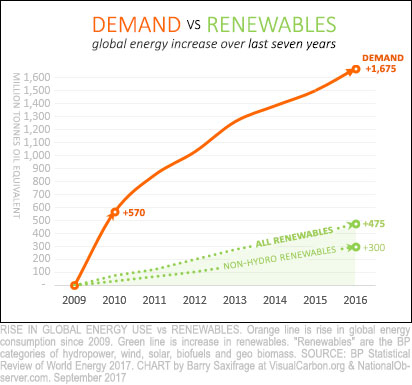
To illustrate, I created this new chart on the right from the BP data.
The orange line shows the increase in global energy demand since 2009.
Compare all that new demand to the top green line showing the increase in renewable energy. As you can see, renewables expanded only enough to cover about a quarter of new demand.
In fact, all the expansion of renewables over the last seven years isn't enough to cover even the single-year demand surge of 2010. Sure that was a big year for demand as the world emerged from a global recession. But those last seven years have also been the all-time biggest years ever for renewable energy.
The situation looks even worse if you don't like the idea of relying on expanding hydropower dams. That's because hydropower expanded more than any other renewable over those years. The lower green line shows the increase from all the non-hydro renewables: wind, solar, biofuels and biomass.
So, any guesses what filled that huge gap between renewables and demand? Yep.
Fossil fuel expansion trumps all renewables
Instead of prioritizing climate-safe renewables, humanity met most of the rising energy demand by burning ever more fossil carbon. My next chart shows the renewables-crushing scale of the recent fossil fuel expansion.
The huge bar on the left shows global fossil fuel burn last year. The tiny right bar shows all renewable energy use last year. Quite a mismatch, eh? But the key thing to notice is the yellow part of each bar. This shows how much each type of energy increased over the last decade.
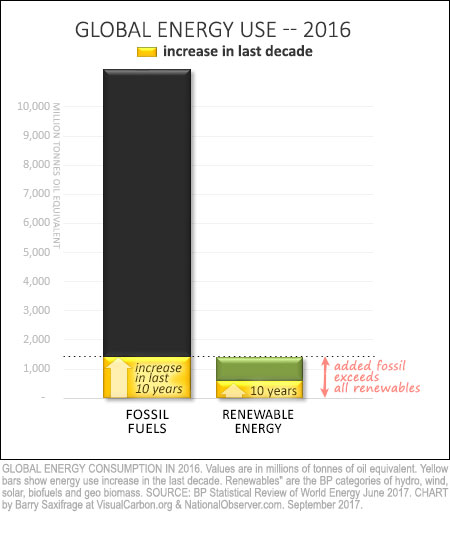
As you can see, we expanded fossil fuels twice as much as renewables. Actually, 2.4 times more. When people have wanted more energy, they have mostly decided to burn more fossil carbon, not install more renewables.
In fact, as the red arrows show, the last decade’s increase in fossil fuels was so huge that it single-handedly exceeds all the renewable energy supply we’ve ever built.
In other words, all the world's hydropower dams, solar installations, biomass burning, biofuels and wind farms produce less energy than just the recent expansion in fossil fuels.
The new business as usual: more of both
Here's another chart showing how things have played out over the last decade.
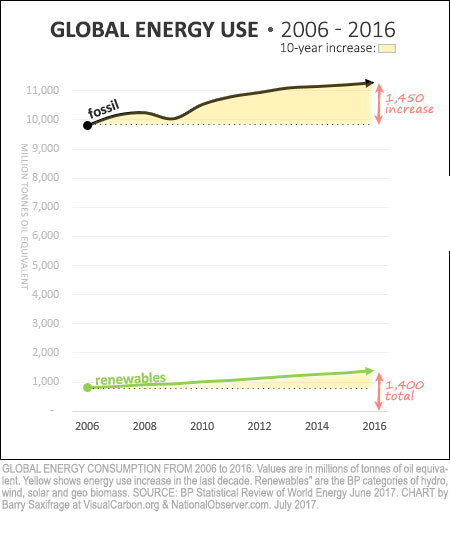
The black line shows fossil fuel use. The green line shows renewables. And, again, yellow shows how much each increased over the last decade.
This chart lets you see how both fossil fuels and renewables continue to rise at the same time.
As with the previous chart, the red arrows point out that fossil fuels expanded more in this decade than all renewables combined have ever expanded.
This chart certainly shows that renewables are growing at a good clip. But it also shows that fossil fuels keep expanding even more. There is no indication here that fossil burning is going start declining rapidly as needed. I don't even see any sign it is going to stop rising!
Instead, the world isn't even coming close to expanding renewables enough to meet the annual increases in energy demand.
Cherry picking climate hope?
Don't get me wrong, I'm a huge fan of renewables. I've got grid-tie solar panels on my roof and I'm an avid daily reader of the renewable energy press. I see renewables as a critical and necessary part of a climate-sane future.
But renewables aren't the metric that will determine our climate future. Renewables can — and currently are — prospering even as fossil fuels expand and we accelerate into the climate crisis.
Focusing on just the positive renewable energy news feels to me like cherry-picking climate hope. It's tempting, for sure, but can distract from what actually determines our climate fate: how much fossil fuel we burn. And by that measure we are still heading ever further from safety while our time to turn around is running out.

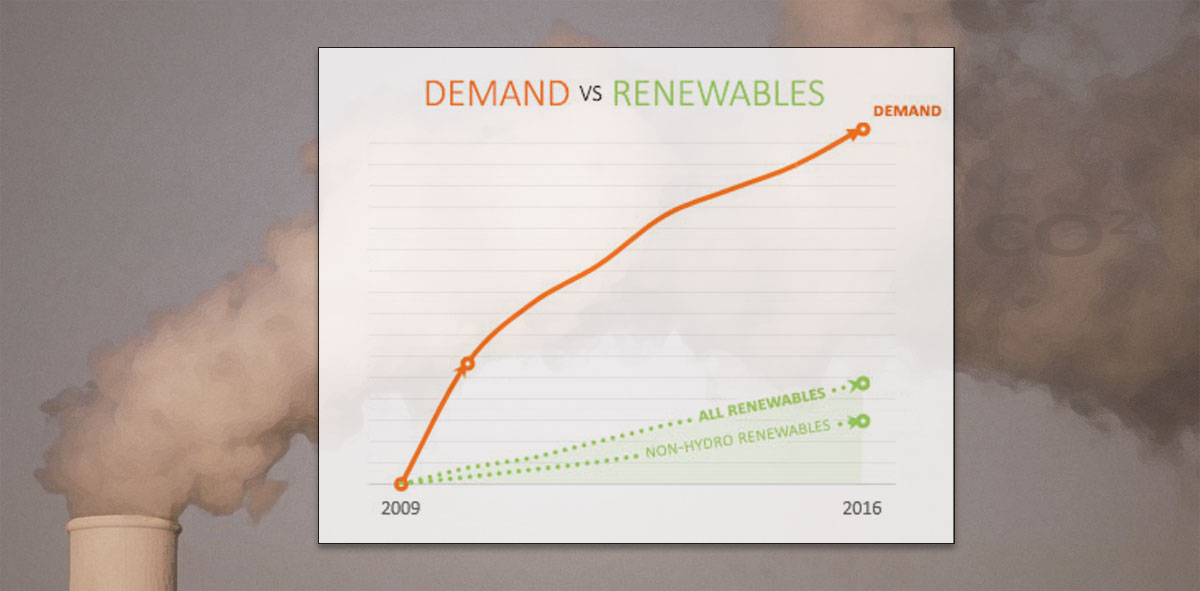

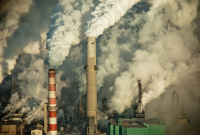
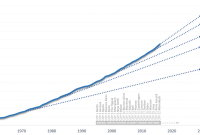
Comments
Report from the U.S. Energy Information Administration (EIA) shows the same trend. It predicts that fossil fuels will account for around 77% of energy use in 2040. In the long term, the EIA's International Energy Outlook (Sept. 14, 2017) Reference case projects increased world consumption of marketed energy from all fuel sources (except coal where demand is essentially flat) through 2040. Renewables are the world's fastest growing energy source, with consumption increasing by an average 2.3%/year between 2015 and 2040. The world's second fastest growing source of energy is nuclear power with consumption increasing by 1.5%/year over that period.
Liquid fuels consumed for transportation increases by an average of 0.7%/year from 2015 to 2040. The transportation sector accounts for 60% of the total increase in delivered liquid fuels use.
In Canada, total GHG emissions have increased at an average annual growth of 0.7% between 1990 and 2014. GHG emissions from the transportation sector, the second largest emitter in Canada after the oil and gas industry, has had a stronger growth since the 1990, at an average annual rate of 1.1% per year... Despite improved fuel economy and emission standards in most vehicles, the growing trend of "consumer preference" for SUVs and light trucks has resulted in GHG emissions from light trucks more than doubling, from 22 Mt in 1990 to 50 Mt in 2014, which has more than offset reductions in passenger car emissions from 52 Mt in 1990 to 36 Mt in 2104.
(source: NEB Market Snapshot, 2016-07-14: "Increased GHG emissions from the transportation sector reflect major consumer and business trends")
It shows how "consumer choices" can play an important role in reducing GHG emissions. Bigger cars, more flying and travelling, and more consumption in general are the principal drivers of accumulating GHG emissions. We have (that includes consumers and governments) to make better choices if we want to significantly reduce global emissions. There is some hope, but it is rapidly fading away.
Thanks, René, for bringing up the latest US EIA report on this.
The US EIA projects -- under current trends and policies -- that fossil fuel use will be 43% higher in 2050 and still increasing! That scenario is game over for a safe climate.
I also agree that both consumers and governments could change the climate pollution trajectory rapidly with different choices. Not happening yet in Canada, though, as you point out.
Thank you for this sobering information, presented so clearly it can be understood. No smoke screens just uncomfortable reality. Lois
Many thanks for this timely piece. Yes, it's important to recognize the progress we have made with renewables in recent years, to avoid despondency in this era of Trumped up insanity among climate change deniers. But it's at least as important to have a realistic idea of the scale of the challenge facing us NOW if we intend to seriously address the deepening climate crisis.
Great article Barry. And Trump and the American ITC (International Trade Commission) want to impose tariffs on foreign suppliers of renewable energy products. The prices for solar panels, etc. have dropped significantly over the past five years. With proposed tariffs, American consumers will have to pay double the 2011 price.